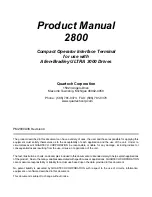
z
Connection Procedure
1.
Using a screwdriver, loosen the four mounting screws on the PT’s
back cover.
2.
Remove the mounting screws, grasp the cover by the handholds,
and lift out the cover.
3.
When the cover has been removed and the back of the PT is open,
the I/O connector and interface on the board in the PT can be seen.
DIP Switch
Battery interface
Serial interface
External output interface
24-VDC interface
ON
DIP switch pins are ON
when set to the right.
4.
Using your hand, lightly tighten the waterproof packing while it is
attached to the housing. Then use a wrench to tighten the waterproof
packing to a force of 4.0 to 6.0 N
⋅
m to secure it in place.
5.
Insert the cable into the PT until the heat-shrinking tube is visible
on the inside.
Heat-shrinking tube
6.
Insert the cable packing into the inside of the cable clamp housing
and lightly tighten the cap by hand.
Cable packing
Insert the Special
Cable into the PT.
7.
Tighten the cap with a wrench. Use a tightening force of 2.0 to 3.0 N
⋅
m.
Precautions for Safe Use
Inspect the cable periodically to see if
it has become loose.
8.
Connect all of the connectors.
1
2
3
4
O
N
Serial interface:
White, 20-pin connector
24-VDC power supply interface:
Black, 3-pin connector
External output interface:
Black, 18-pin connector
Serial interface
External output interface
24-VDC interface
9.
When using RS-422A communications, turn ON DIP switch pin 1
(terminating resistance ON) only when the PT is connected as the
last communications node.
Note:
DIP switch pin 1 connects and disconnect the terminating
resistance. Always leave pins 2 to 4 turned OFF (default
setting).
10.
Replace the cover, insert the four mounting screws, and tighten
them to a force of 0.4 N
⋅
m.
Mounting to a Control Panel
A UL-standard cable connection example is given below.
1.
When using a UL-standard cable, it is necessary to cut a hole
in the control panel to secure the cable clamp.
Cable Clamp Mounting Hole Dimension
23
±
0.2 mm
2.
Feed the UL-standard cable through the hole, then secure the
cable clamp to the control panel from the inside using the lock
nut. When using the NSH5-232UL-3M/10M, always connect the
relay cable, which is equipped with an RS-232C connector, after
feeding the UL-standard cable through the hole in the wall of the
control panel. Tighten the lock nut to a force of 2.0 to 3.0 N
⋅
m.
Cap
Cable
packing
Housing
Lock nut






















